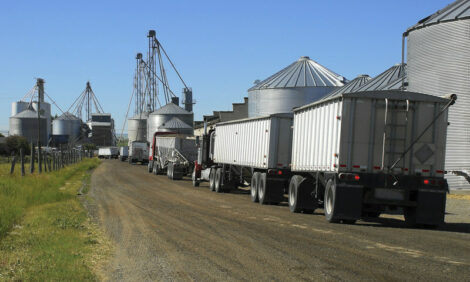



Classical Swine Fever in Domestic Pigs in Latvia
LATVIA - An update on Classical Swine Fever in domestic swine in Latvia has been prepared by the UK's Department for Environment, Food and Rural Affairs' Veterinary Science Team.Defra's International Disease Monitoring (IDM) team monitors outbreaks of high impact diseases around the world. Classical Swine Fever (CSF) is among those diseases of major concern, according to authors, Dr Helen Roberts and Professor Trevor Drew.
Disease report
Following the report of Classical Swine Fever (CSF) in wild boar, Latvia has now reported three outbreaks in backyard domestic pigs in the same region, Kraslava (OIE, 2012; see map). In two of the three outbreaks, sick or dead fattening pigs were reported.

Situation assessment
The samples from the wild boar were sent to the EU reference laboratory (EURL) at the University of Veterinary Medicine Hannover, Germany. The results confirm the presence of genotype 2.3 (European Commission, 2012).
Seven serum samples from domestic pigs and wild boar, also submitted to the EURL, were tested in an assay to measure the relative antibody neutralisation titres to CSF genotype 1.1 and genotype 2.3. All sera showed highest antibody titres to CSF genotype 2.3. This confirms that infection with a 2.3 virus is involved in infections among domestic pigs and wild boar in the region.
Vaccination is carried out in wild boar and domestic pigs in some areas of the EU and neighbouring countries. However, it is prohibited in Latvia according to the OIE report. Vaccine C consists of CSF genotype 1.1, while vaccines LK and CS which are in use in Russia are genotype 1.2. Genotype 2.3 circulates widely in wild boar in Eastern Europe.
Given the geographical locations of the wild boar cases and the domestic swine outbreaks in Latvia, it is reasonable to assume there is an epidemiological link. Therefore these latest outbreaks in backyard pigs are more likely a result of contact with infected wild boar or products derived thereof.
Conclusions
Currently, the authors consider there to be a negligible likelihood of introduction of CSF virus from Latvia to the UK via legal trade in live pigs and their germplasm.
They will continue to emphasise the importance of prompt reporting of suspect disease in pigs, and the implementation and maintenance of appropriate biosecurity measures, particularly considering the risk of disease spread by fomite transmission and strict compliance with the swill feeding ban.
The authors add that they will continue to monitor the situation.
References
All Commission Legislation is available from the Commission web site.
Defra (2012). Classical Swine Fever in wild boar in Latvia.
European Commission (2012) CSF in Latvia. Fax 004/2012 received 29/11/2012.
OIE (2012) CSF in Latvia. Follow-up report No. 1. Ref: 12643 28/11/2012.
Further ReadingFind out more information on swine fevers by clicking here. |








